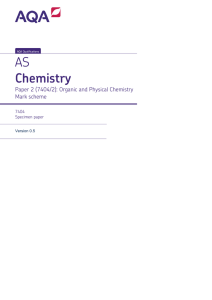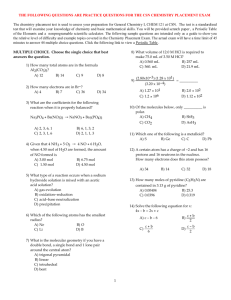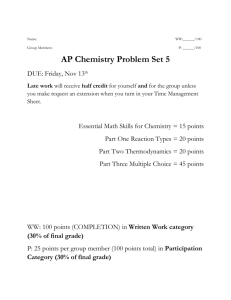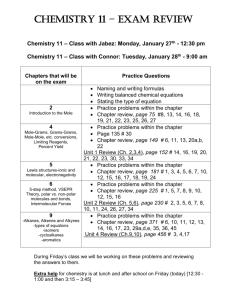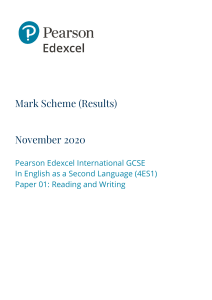AS Chemistry Specimen mark scheme Paper 1
advertisement
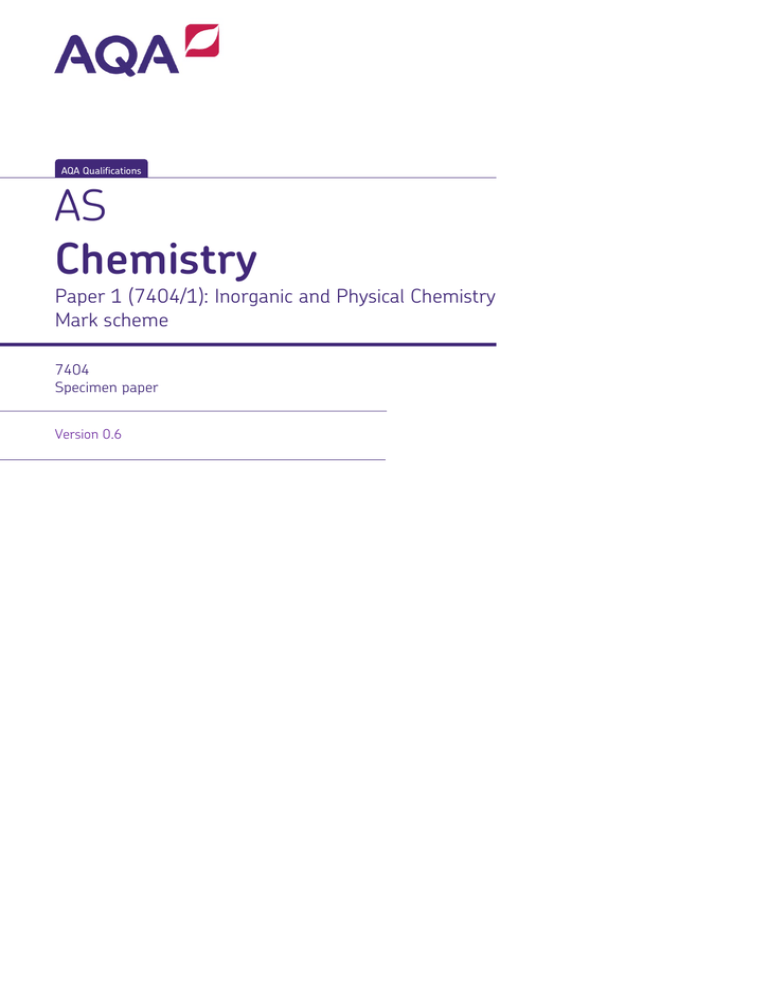
AQA Qualifications AS Chemistry Paper 1 (7404/1): Inorganic and Physical Chemistry Mark scheme 7404 Specimen paper Version 0.6 MARK SCHEME – AS Chemistry – Specimen paper 1 Section A Question Marking guidance 01.1 1s22s22p63s23p64s2 01.2 Ca(s)+ 2H2O(l) 01.3 Oxidising agent 01.4 Ca(g) 2+ – Ca (aq) + 2OH (aq) + H2(g) + – Ca (g) + e Mark AO Comments 1 AO1a Allow correct numbers that are not superscripted 1 AO2d State symbols essential 1 AO2c 1 AO1a State symbols essential Allow ‘e’ without the negative sign 01.5 Decrease 1 AO1a If answer to ‘trend’ is not ‘decrease’, then chemical error = 0/3 Ions get bigger / more (energy) shells 1 AO1a Allow atoms instead of ions Weaker attraction of ion to lost electron 1 AO1a 2 of 13 MARK SCHEME – AS Chemistry – Specimen paper 1 Question 02.1 Marking guidance Mark AO Abundance of third isotope = 100 – 91.0 –1.8 = 7.2% 1 AO1b (32 × 91) + (33 × 1.8) + (y × 7.2) = 32.16 100 1 AO2f 7.2y = 32.16 × 100 – 32 × 91 – 33 × 1.8 = 244.6 1 AO2f 1 AO1b A high voltage is applied to a sample in a polar solvent 1 AO1b the sample molecule, M, gains a proton forming MH+ 1 AO1b 1 AO1b 1 AO1b Comments y = 244.6 / 7.2 = 33.97 y = 34 02.2 Answer must be rounded to the nearest integer (for electrospray ionisation) OR (for electron impact ionisation) the sample is bombarded by high energy electrons + the sample molecule loses an electron forming M 3 of 13 MARK SCHEME – AS Chemistry – Specimen paper 1 02.3 Ions, not molecules, will interact with and be accelerated by an electric field 1 AO2e Only ions will create a current when hitting the detector 1 AO2e 4 of 13 MARK SCHEME – AS Chemistry – Specimen paper 1 Question Marking guidance AO 1 AO1a 03.1 C(s) + 2F2(g) 03.2 Around carbon there are 4 bonding pairs of electrons (and no lone pairs) 1 AO1a Therefore, these repel equally and spread as far apart as possible 1 AO1a ∆H = Σ ∆fH products – Σ ∆fH reactants or a correct cycle 1 AO1b Hence = (2 × –680) + (6 × –269) – (x) = –2889 1 AO1b –1 1 AO1b 1 AO3 1a 1 AO3 1a 1 AO3 1a 1 AO3 1b 03.3 CF4(g) Mark x = 2889 – 1360 – 1614 = –85 (kJ mol ) 03.4 Comments State symbols essential –1 Score 1 mark only for +85 (kJ mol ) Bonds broken = 4(C–H) + 4(F–F) = 4 × 412 + 4 × F–F Bonds formed = 4(C–F) + 4(H–F) = 4 × 484 + 4 × 562 Both required –1904 = [4 × 412 + 4(F–F)] – [4 × 484 + 4 × 562] 4(F–F) = –1904 – 4 × 412 + [4 × 484 + 4 × 562] = 632 –1 F–F = 632 / 4 = 158 (kJ mol ) The student is correct because the F–F bond energy is much less than the C–H or other covalent bonds, therefore the F–F bond is weak / easily broken Relevant comment comparing to other bonds (Low activation energy needed to break the F–F bond) 5 of 13 MARK SCHEME – AS Chemistry – Specimen paper 1 Question 04.1 04.2 04.3 Marking guidance Mark AO amount of X = 0.50 – 0.20 = 0.30 (mol) 1 AO2h amount of Y = 0.50 – 2 × 0.20 = 0.10 (mol) 1 AO2h Axes labelled with values, units and scales that use over half of each axis 1 AO2h Curve starts at origin 1 AO2h Then flattens at 30 seconds at 0.20 mol 1 AO2h Expression = Kc = [Z] 2 [X][Y] 1 AO1a 1 AO2b 1 AO1b Darkened / went more orange 1 AO2g The equilibrium moved to the right 1 AO2g To oppose the increased concentration of Y 1 AO2g The orange colour would fade 1 AO3 1a [Y]2 = [Z] [X] Kc [Y] = (0.35 / 0.40 × 2.9) 04.4 04.5 0.5 = 0.5493 = 0.55 (mol dm–3) Comments All three of values, units and scales are required for the mark Answer must be to 2 significant figures 6 of 13 MARK SCHEME – AS Chemistry – Specimen paper 1 Question 05.1 Marking guidance 2NaBr + 2H2SO4 Na2SO4 + Br2 + SO2 + 2H2O Mark AO 1 AO1a Comments Allow ionic equation 2Br– + 2H2SO4 – – Br ions are bigger than Cl ions – Therefore Br ions more easily oxidised / lose an electron more – easily (than Cl ions) 1 AO2c 1 AO2c 2– Br2 + SO4 + SO2 + 2H2O 7 of 13 MARK SCHEME – AS Chemistry – Specimen paper 1 05.2 This question is marked using levels of response. Refer to the Mark Scheme Instructions for Examiners for guidance on how to mark this question. Level 3 All stages are covered and the explanation of each 5–6 stage is generally correct and virtually complete. Stages 1 and 2 are supported by correct equations. marks Answer communicates the whole process coherently and shows a logical progression from stage 1 to stage 2 and then stage 3. The steps in stage 3 are in a logical order. Level 2 3–4 marks All stages are covered but the explanation of each stage may be incomplete or may contain inaccuracies OR two stages are covered and the explanations are generally correct and virtually complete. Answer is mainly coherent and shows a progression through the stages. Some steps in each stage may be out of order and incomplete. Level 1 1–2 marks 6 2 AO1a 4 AO3 2b Indicative chemistry content Stage 1: formation of precipitates • Add silver nitrate • to form precipitates of AgCl and AgBr • AgNO3 + NaCl → AgCl + NaNO3 • AgNO3 + NaBr → AgBr + NaNO3 Stage 2: selective dissolving of AgCl • Add excess of dilute ammonia to the mixture of precipitates • the silver chloride precipitate dissolves – + • AgCl + 2NH3 → Ag(NH3)2 + Cl Stage 3: separation and purification of AgBr • Filter off the remaining silver bromide precipitate • Wash to remove soluble compounds • Dry to remove water Two stages are covered but the explanation of each stage may be incomplete or may contain inaccuracies, OR only one stage is covered but the explanation is generally correct and virtually complete. Answer includes some isolated statements, but these are not presented in a logical order or show confused reasoning. Level 0 0 marks Insufficient correct chemistry to warrant a mark. 8 of 13 MARK SCHEME – AS Chemistry – Specimen paper 1 05.3 Cl2 + 2HO – − OCl is +1 – – OCl + Cl + H2O 1 AO1a 1 AO2b Both required for the mark – Cl is –1 9 of 13 MARK SCHEME – AS Chemistry – Specimen paper 1 Question Marking guidance Mark AO 06.1 Comments Extended response Maximum of 7 marks for answers which do not show a sustained line of reasoning which is coherent, relevant, substantiated and logically structured. Stage 1: appreciation that the acid must be in excess and calculation of amount of solid that permits this. 1 AO2d Moles of acid = 50.0 × 0.200/1000 = 1.00 × 10 mol 1 AO3 2a 2 mol of acid react with 1 mol of calcium hydroxide therefore moles of solid weighed out must be less than half the moles of acid = 0.5 –2 –3 × 1.00 × 10 = 5.00 × 10 mol 1 AO3 2b 1 AO3 2a 1 AO3 2b 1 AO3 2b Moles of calcium hydroxide = –3 5.00 × 10 – (v/2 × conc NaOH)/1000 = z mol 1 AO3 2a Mr = mass of solid / z 1 AO3 2a Statement that there must be an excess of acid –2 –3 Mass of solid must be < 5.00 × 10 × 74.1 = < 0.371 g Stage 2: Experimental method. Measure out 50 cm3 of acid using a pipette and add the weighed amount of solid in a conical flask –3 Titrate against 0.100 (or 0.200) mol dm NaOH added from a burette and record the volume (v) when an added indicator changes colour Stage 3: How to calculate Mr from the experimental data. 10 of 13 MARK SCHEME – AS Chemistry – Specimen paper 1 06.2 –2 Moles of calcium chloride = 3.56 / 111.1 = 3.204 × 10 –2 –2 Moles of calcium sulfate = 3.204 × 10 × 83.4/100 = 2.672 × 10 –2 Mass of calcium sulfate = 2.672 × 10 × 136.2 = 3.6398 = 3.64 (g) 1 AO2h 1 AO2h 1 AO2h Answer must be to 3 significant figures 11 of 13 MARK SCHEME – AS Chemistry – Specimen paper 1 Question Marking guidance Mark AO 07.1 Comments Extended response calculation Stage 1 Mr for Mg(NO3)2 = 148.3 –2 -4 Moles of Mg(NO3)2 = 3.74 × 10 148.3 = 2.522 × 10 mol 1 AO2h 1 AO2h Stage 2 Total moles of gas produced = 5/2 × moles of Mg(NO3)2 –4 = 5/2 × 2.522 × 10 –4 = 6.305 × 10 If ratio in stage 2 is incorrect, maximum marks for stage 3 is 2 Stage 3 PV=nRT so volume of gas V = nRT/P –4 –5 V = nRT = 6.305 × 10 × 8.31 × 333 = 1.745 × 10 m P 1.00 × 105 3 –5 6 3 3 V = 1.745 × 10 × 1 × 10 = 17.45 cm = 17.5 (cm ) 07.2 Some of the solid is lost in weighing product / solid is blown away with the gas 1 AO2h 1 AO2h 1 AO1b 1 AO3 1b Answer must be to 3 significant figures (answer could 3 be 17.4 cm dependent on intermediate values) 12 of 13 MARK SCHEME – AS Chemistry – Specimen paper 1 Section B In this section, each correct answer is awarded 1 mark. Question Key AO 8 D AO1a 9 D AO1b 10 A AO3 1b 11 B AO3 2a 12 B AO2a 13 A AO2a 14 C AO1a 15 C AO1a 16 D AO2b 17 D AO2a 18 B AO1a 19 A AO2a 20 C AO2b 21 B AO1b 22 B AO2b
